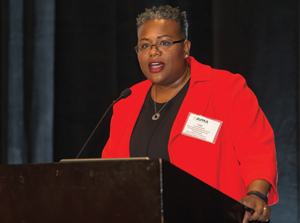Worth the price of admission?
From 2002-2013, the number of veterinary college applicants increased by more than half—from 4,440 to 6,769, according to figures from the Association of American Veterinary Medical Colleges’ Veterinary Medical College Application Service. Meanwhile, the mean debt-to-income ratio for recent veterinary graduates rose from 1.3:1 in 2000 to roughly 1.9:1 in 2015, based on the latest AVMA economic report (see story). To better understand this seemingly paradoxical situation, the AAVMC is placing an increasing emphasis on assessing the financial literacy and behaviors of applicants and veterinary students.
New data from individuals who applied for admission in 2014 (ie, students in the class of 2018) suggest that financial literacy of these individuals was no different from that of their peers. But anecdotally, it appears their passion for the profession contributed to their willingness to pay the increasing cost of attendance. Lisa Greenhill, AAVMC associate executive director for institutional research and diversity, who has a doctorate in education, frequently parses what aspiring veterinary students post online. “You’ll see there is concern among applicants about the economics of the profession, but there’s a tenor of ‘I don’t care because I want to be a veterinarian, and I’ll have to learn that it is OK not to make money.’ That should concern us. This is the message they are parroting back,” she said.
“There’s this attitude of, ‘I’ve waited all my life, I don’t care what it costs,’ which is noble, but that can lead to bad decision making,” Dr. Greenhill added. “There is a passion in this profession we tend to reward, sometimes to our detriment.”
She and others talked about the demand for veterinary education and how behaviors influence that demand during the 2015 AVMA Economic Summit Oct. 21 in Rosemont, Illinois.


Dr. Greenhill co-authored a study earlier this year, “Veterinary school applicants: financial literacy and behaviors” (JVME 2015;42:89-96), based on data collected from a survey of applicants submitting through the AAVMC’s Veterinary Medical College Application Service in 2015. The service processes applications for every U.S. veterinary college but Texas A&M University along with about half of the international institutions accredited by the AVMA Council on Education.
The study results show no significant differences in financial literacy between the typical undergraduate student and the typical preveterinary student. Veterinary school applicants believe themselves to be good personal finance managers; they maintain checking (98.3 percent) and savings (89 percent) accounts, modest investments (31.3 percent), and emergency funds (33.6 percent). However, one in four applicants carries revolving credit balances and makes only minimum monthly payments. And in the past year, only 36.5 percent had checked their credit score, and only 22.1 percent had asked for advice from a financial professional.
To assess applicants’ awareness of the debt load of recent veterinary school graduates, the investigators asked them to estimate the mean 2013 veterinary school graduate’s debt. Responses covered a large range, from $0 to $500,000. The mean estimate was $149,960, roughly similar to the reported mean educational debt of $146,221 reported by respondents to the AVMA’s 2013 senior student survey.
How applicants make decisions
Despite the ongoing discussions and numerous articles about the student debt crisis, most applicants do not report a high degree of concern about servicing their debt. That’s according to preliminary results from another study, “Concerns of veterinary applicants and students,” which was authored by Dr. Greenhill and Bridgette Bain, PhD, statistical data analyst with the AVMA Veterinary Economics Division. On the basis of VMCAS respondent data for 2014, of the 83 percent of all applicants who reported having concern about their ability to service their debt, less than 30 percent reported being moderately or extremely concerned about it.
The changes in the applicant pool, and the broader availability of seats, have led the ratio of applicants to seats to slowly decline in recent years. American students continue to explore the availability of seats at institutions outside the U.S., thus spreading the quality of the applicant pool more thinly as colleges compete for talented students. While the ratio changes suggest the need for colleges to admit less-qualified applicants to fill their seats, admissions data and practices do not support this hypothesis. While the pool is being stretched, a historical analysis of the applicant pool suggests that, despite its shallowness in terms of numbers, there are still many qualified applicants who bear the markers of future successful students.
2015 AVMA Report on the Market for Veterinary Education
Similarly, applicants reported being concerned about finding employment after completing their veterinary degrees; however, only 23 percent expressed being moderately or extremely concerned.
That said, the 2013 VMCAS applicants gave higher estimates of what they were willing to pay for veterinary school (a mean of $197,242) than the 2014 applicants (a mean of $172,853), according to a presentation at the economic summit by Michael Dicks, PhD, Veterinary Economics Division director.
Through better education on the cost of attending veterinary college, Dr. Dicks said the hope is applicants’ estimates will continue to get closer to reality. But Dr. James Lloyd, dean of the University of Florida College of Veterinary Medicine, said at the summit, “When we focus solely on the financial dimensions of the market, we’re likely to miss this boat; it’s only a start. This is a multifactorial decision process that demands broader analysis.”
He pointed out that among the 2015 VMCAS applicants who responded to the survey, 57.4 percent said they knew they had wanted to be a veterinarian since they were 10 or younger.
“Students, then, aren’t thinking about debt-to-income ratios. We have to think about what else it is that is driving demand for the profession,” he said.
Dr. Lloyd outlined the following factors that also contribute to a student choosing to go to veterinary college:
- Personal and parental effects, such as academic abilities, self-motivation, and emotional factors.
- Parental support and education.
- Cultural, educational, and social context, such as extended family and church and community leaders.
- Peers and school counselors.
- Institutional issues, such as location, cost, financial aid, environment, and reputation.
- Economic dimensions, such as perceived financial benefits, economic access, and willingness to pay or borrow.
“We need to continue to work together, study demand-choice factors, and strengthen recruitment. We want to have as many people applying for the profession as possible so we have the best and the brightest,” Dr. Lloyd said.
Ups and downs
Historically, the veterinary applicant pool has seen a 16- to 19-year cycle of ups and downs, although currently, the cycle appears to have hit a plateau. Preliminary data from the 2016 VMCAS application cycle show a total of 6,660 students applied for admission to the class of 2020. Compared with the 6,681 students who sought admission the previous year, this represented a decrease of 1 percent. During the year before that, there were 6,744 applicants.
“We can’t seem to tie (the cycles) to a particular event. It’s not tied to recession cycles, so we’re not sure why it happens,” Dr. Greenhill said. “Last year, I predicted we were on a downward trend. Our VMCAS cycle closed in mid-September, and we saw a modest decrease. I’m not yet ready to say it’s a trend, but certainly it’s something we’re concerned about and trying to make plans around.”
The applicant-to-seat ratio has been in decline since 2008, going from 2.4:1 to 1.6:1 in 2014. The AAVMC will have a new ratio soon based on the 2015 data.
At the 2015 AVMA Economic Summit, Dr. Dicks said, “We’ll see whether the applicant pool will continue to flat-line or drop. Will they make the decision to apply or not to apply when they figure out what they’re willing to pay? Let’s say they find they can’t go in-state. Will they pay the extra to go out-of-state or say they can’t afford it (and do something else)? Many say, ‘I have the opportunity, I might as well,’ so they go out-of-state. That’s an interesting characteristic and something we’ll have to take a look at.”

Click to enlarge
He added, “Based on the last three to four years, I think the number of applicants will continue to slide, not greatly, but the applicant-to-seat ratio will approach 1.4:1, which is as low as it’s ever been. It may be closer to 1:1 or 1.1:1, which should have us thinking whether we should continue to expand seats or do something about the seats we have and market them better.”
Dr. Greenhill said she’s not as concerned about the decreasing applicant pool because the mean first-year GPA of veterinary students has hovered around 3.5 to 3.6 for years and isn’t much different from that for similar professions. “The pool is deeper than we give credit for and can absorb the recent growth in schools,” she said, noting that most of the big gains in seats have already occurred.
Related JAVMA content:
College enrollment up, applicant-to-seat ratio down (May 1, 2015)
Letting the numbers tell the story (May 1, 2013)
Making progress one meeting at a time (Oct. 1, 2012)